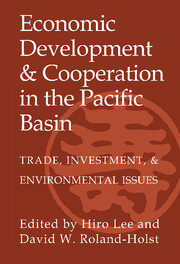 Economic Development and Cooperation in the Pacific Basin
Economic Development and Cooperation in the Pacific Basin Book contents
- Frontmatter
- Contents
- Acknowledgments
- List of Contributors
- I Introduction and Overview
- II U.S.-Japan and Asian Trade Patterns
- III Regional Trading Arrangements in the Pacific Basin
- 4 Should East Asia Go Regional?
- 5 Political Feasibility and Empirical Assessments of a Pacific Free Trade Area
- 6 Regionalism in the Pacific Basin: Strategic Interest of ASEAN in APEC
- IV Foreign Direct Investment: Determinants and Consequences
- V Trade, Resources, and the Environment
- Index
5 - Political Feasibility and Empirical Assessments of a Pacific Free Trade Area
Published online by Cambridge University Press: 19 May 2010
- Frontmatter
- Contents
- Acknowledgments
- List of Contributors
- I Introduction and Overview
- II U.S.-Japan and Asian Trade Patterns
- III Regional Trading Arrangements in the Pacific Basin
- 4 Should East Asia Go Regional?
- 5 Political Feasibility and Empirical Assessments of a Pacific Free Trade Area
- 6 Regionalism in the Pacific Basin: Strategic Interest of ASEAN in APEC
- IV Foreign Direct Investment: Determinants and Consequences
- V Trade, Resources, and the Environment
- Index
Summary
TOWARD A FREE TRADE AGREEMENT IN EAST ASIA OR THE PACIFIC BASIN?
During the past quarter-century, intraregional trade has expanded dramatically in East Asia and the Pacific Basin. In 1970, 29.8 percent of gross trade (the sum of exports and imports) was intraregional among ten selected countries in East Asia -Japan, China, the newly industrialized economies (NIEs: South Korea, Taiwan, Hong Kong, and Singapore), and the ASEAN-4 (Malaysia, Thailand, Indonesia, and the Philippines). By 1995, intra-East Asian trade accounted for 49.2 percent of gross trade flows. Similarly, intraregional trade among the countries of Pacific Basin – the ten East Asian countries, along with the United States, Canada, Mexico, Australia, and New Zealand - climbed from 58.4 percent in 1970 to 72.1 percent in 1995. Emerging in tandem with the formation of the European Union (EU) in 1992, this expansion in intraregional trade led many analysts to ponder the possibility of an East Asian or a Pacific free trade agreement.
While much has been written about the significance of expanded intraregional trade flows in East Asia and the Pacific Basin (e.g., Drysdale and Garnaut, 1993; Frankel, 1993; Krugman, 1991; Petri, 1993; Saxonhouse, 1993; Yamazawa, 1992, 1994), considerably less attention has been paid to the political feasibility and the economic benefits and costs of such. Is an East Asian free trade area (EAFTA) agreement politically feasible? What about a Pacific free trade area (PAFTA)? How likely is it that the governments of the various countries of the region can successfully negotiate an agreement establishing a free trade area?
- Type
- Chapter
- Information
- Economic Development and Cooperation in the Pacific BasinTrade, Investment, and Environmental Issues, pp. 160 - 202Publisher: Cambridge University PressPrint publication year: 1998
- 1
- Cited by


